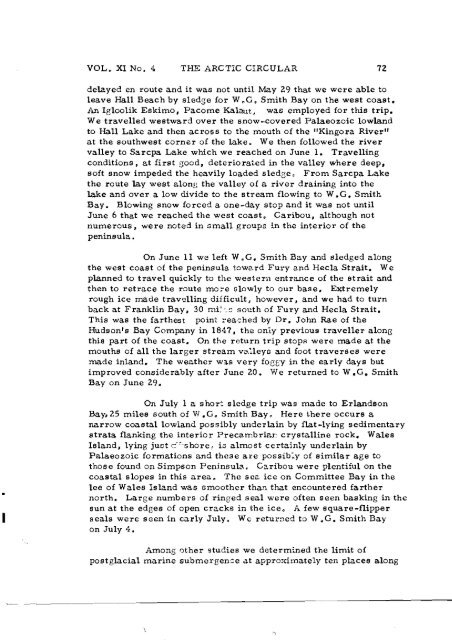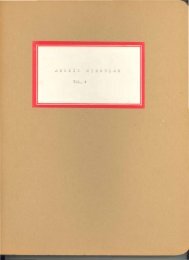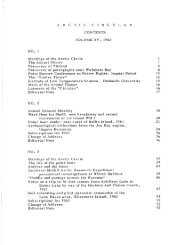Volume 11, 1958 - The Arctic Circle - Home
Volume 11, 1958 - The Arctic Circle - Home
Volume 11, 1958 - The Arctic Circle - Home
You also want an ePaper? Increase the reach of your titles
YUMPU automatically turns print PDFs into web optimized ePapers that Google loves.
VOL. Xl No, 4 THE ARCTIC CIRCULAR 7Z<br />
delayed en route and it was not until May 29 that we were able to<br />
leave Hall Beach by sledge for W.G, Smith Bay on the west coast.<br />
An 19loolik Eskimo, Pacome Kalaut, was employed for this trip.<br />
We travelled westward over the snow..covered Palaeozoic lowland<br />
to Hall Lake and then across to the mouth of the "Kingora River"<br />
at the southwest corner of the lake, We then followed the river<br />
valley to Sarcpa Lake which we reached on June 1. Travelling<br />
conditions. at first good, deteriorated in the valley where deep,<br />
soft snow impeded the heavily loaded sledge" From Sarcpa Lake<br />
the route lay west alon" the valley of a river draining into the<br />
lake and over a low divide to the stream flowing to W .G. Smith<br />
Bay. Blowing snow forced a one-day stop and it was not until<br />
June 6 that we reached the west coast, Caribou, although not<br />
numerous, were noted in small groups in the interior of the<br />
peninsula.<br />
On June <strong>11</strong> we left W.G. Smith Bay and sledged along<br />
the west coast of the peninsula toward Fury and Hecla Strait. We<br />
planned to travel quickly to the western entrance of the strait and<br />
then to retrace the route mo=e slowly to our base. Extremely<br />
rough ice made travelling difficult, however, and we had to turn<br />
back at Franklin Bay, 30 mi>~s south of Fury and Hecla Strait.<br />
This was the farthest point =ea·~hed by Dr. John Rae of the<br />
Hudson's Bay Company in 1847, the only previous traveller along<br />
this part of the coast. On the return trip stops were made at the<br />
mouths of all the larger stream vi.'.:leys and foot traverses were<br />
made inland. <strong>The</strong> weather W3,S very fOGGY in the early days but<br />
improved considerably after June 20. We returned to W .G. Smith<br />
Bay on June 29.<br />
•<br />
I<br />
On July 1 a short sledge trip was made to Erlandson<br />
Bay, 25 miles south of W •G, Smith Bay. Here there occurs a<br />
narrow coastal lowland possibly underlain by flat-lying sedimentary<br />
strata flanking the interior Preca.mbriar: crystalline rock. Wales<br />
Island, lying just c"shore, is almost certainly underlain by<br />
Palaeozoic formations and these are possib:y of similar age to<br />
those found on Simpson Peninsula. Caribou were plentiful On the<br />
coastal slopes in this area. <strong>The</strong> sea icc on Committee Bay in the<br />
lee of Wales Island was smoother than that encountered farther<br />
north. Large numbers of rinsed seal were often seen basking in the<br />
sun at the edses of open cracks in the ice, A few square-flipper<br />
seals were seen in early July. We returned tQ W .G. Smith Bay<br />
on July 4.<br />
Among other studies we determined the limit of<br />
postglacial marine submersen~ea.t approximately ten places along












